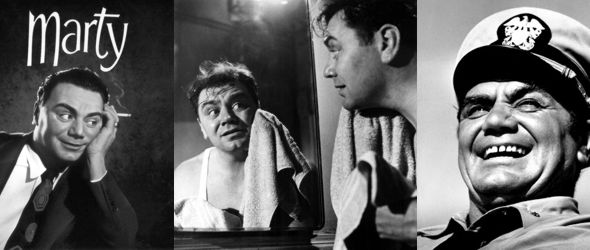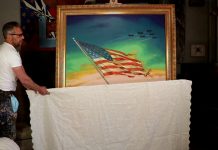“Everything I do has a moral to it. Yes, I’ve been in films that have had shootings. I made The Wild Bunch (1969), which was the beginning of the splattering of blood and everything else. But there was a moral behind it. The moral was that, by golly, bad guys got it. That was it. Yeah.”
Ernest Borgnine was the consummate hero, who often played the villain. He wanted his work to have meaning and he wanted the bad guys to get their due. He began as a “good guy” by enlisting in the Navy and he served from 1935 until 1945. He joined the Navy right out of high school and was discharged in 1941, but he reenlisted after Pearl Harbor was attacked, and served until 1945.
In 1962 he said, “In 1941, I quit the Navy to go to work in a factory in New Haven, Connecticut — 1941, what a year to quit the Navy. I was back in a few months. In the beginning, we had only three boats patrolling the entire Atlantic Coast and I was on one of them. Then, they sent me to Hollywood, Florida. I was assigned to a PY, patrol yacht. The PY was a converted yacht, the S.S. Intrepid. It used to be owned by the Murphy who invented Murphy beds. He (Murphy) took it to Europe and all over before the war. You should have seen what the Navy did to it!”
His first tour of duty was on board the USS Lamberton. During the 1930s the Lamberton operated out of San Diego. It was used for towing targets for surface combatants, submarines, and aircraft, a role that was to serve her well during World War II. She also participated in experimental mine-sweeping exercises and was re-designated DMS-1 (minesweeper, destroyer) in November of 1940.
He served on the USS Sylph that patrolled off of America’s east coast and conducted antisubmarine-warfare activities, then the yacht went on to be used to train sonar men and to test and research equipment for the Atlantic Fleet’s Antisubmarine Development Detachment.
Borgnine left the Navy with the rank of Gunners Mate and earned the Navy Good Conduct Medal, American Defense Service Medal with Fleet Clasp, American Campaign Medal, Asiatic-Pacific Campaign Medal and the World War II Victory Medal.
In October of 2004, Borgnine received the honorary rating of Chief Petty Officer from Master Chief Petty Officer of the Navy, Terry D. Scott, for Borgnine’s support of the Navy and naval families worldwide.
After honorably serving his country, Borgnine used the Gi Bill to study acting at the Randall School of Dramatic Art in Hartford and left there in 1946 to “perform” at the Barber Theater in Abindgon, Virginia. There, he spent fours years working as a driver, scenery-painter, and as a stagehand, until, finally, he was able to talk the “powers that be” into giving him a part on stage. After a few months of acting, he decided to move to New York where he struggled like most new actors, eventually landing a part in Harvey and then as Guildenstern in a production of Hamlet, which allowed him to travel to Denmark and Germany to entertain U.S. servicemen.

Borgnine performed in plays as well as on television, and then made his movie debut in China Corsair in 1951. He was the perfect villain, and got easily typecast, going on to play the sadistic Sergeant “Fatso” Judson in From Here to Eternity in 1953.
In his 1955 performance, as the “ugly” butcher from the Bronx, in Marty, he proved to the world that he was a versatile actor as he disarmed the audience with his genuine tenderness and decency. He won the Academy Award for best-actor in 1955, beating out Frank Sinatra, the late James Dean, who had recently died in a car accident, Spencer Tracy, and James Cagney. He then went on to be cast in some of the best parts in war films, westerns and action movies, such as 1958’s The Vikings”, 1968’s, Ice Station Zebra, and The Wild Bunch in 1969.
Ernest Borgnine was our “everyman” and continued to get leading parts until Hollywood dropped “Joe Average” and returned to casting “glamour boys” like Jimmy Stewart. Borgnine was forced to move on to television, and from 1962 to 1969 he kept us laughing in his part as Quinton McHale in television’s McHale’s Navy.
He tells us in his own words why he starred in McHale’s Navy, “Theater business was disappearing and so were night clubs, which I don’t like to play anyway because they keep me up too late. There were TV guest shots, but how many times can you play Ed Sullivan? My biggest pay was from industrial shows, but they don’t come along too often.”
He costarred in The Poseidon Adventure in 1972 and in 1979 he costarred with Richard Thomas in All Quiet on the Western Front, which helped win the movie an Emmy nomination.
He went on to do other TV series such as Airwolf in the 1980s and The Single Guy in the 1990’s, and he was a Golden Globe nominee for the Hallmark special A Grandpa for Christmas when he was 90 years old.
Borguine’s deep throaty voice even appealed to kids as Mermaid Man on SpongeBob SquarePants.
Borguine continued to act into the late 2000 in movies such as Strange Wilderness in 2008 and in Red in 2010. He made his last movie The Man That Shook the Hand of Vicente Fernandez, and the famous actor still captured every frame in the movie.
Sadly, Ernest Borgnine died on Sunday, July 8, 2012. Lucky for us he came into acting during that short span of time when audiences were tired of pretty faces and demanded something much more raw and natural, like the face and talent of Ernest Borgnine.












































